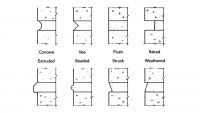October 5, 2011 7:00 AM CDT
Connections between elements are important in applications like roof supports, ledgers, equipment attachments, racking stabilization and piping supports. These attachments can be accomplished by one or more of three main methods: embedment, cast-in-place anchorage, or post-installed anchorage.
In the embedment method, the element is placed within the masonry wall. This is the case in which a beam rests in the wall, and the wall is constructed around the beam. Another example is the placement of a channel or strut in the construction of the wall.
Cast-in-place anchorage is accomplished by placing a “headed bolt,” “j-bolt,” or other type of bolt in the masonry before the grouting process. This attachment method requires the contractor know the location of the anchor and is able to place it accurately in that location.

Chemical or adhesive anchors rely on the bonding of the adhesive material to the masonry. These anchors come in several different types of chemical compounds, including epoxies, ester based resins, acrylates, etc. They contain a resin material and a hardening agent. Typically, they include a mixing mechanism that combines the two parts as the material is placed in the drilled hole. A variety of steel elements may be installed into the masonry with adhesives, including threaded rod and rebar.
Screw anchors cut the masonry as they are installed into a predrilled hole that is smaller than the thread diameter, and provide an interlocking connection with the masonry. Small diameter screw anchors have been used for many years for attachments to masonry walls and, in recent years, large diameter (up to ¾-inch diameter) anchors have become available and are used effectively in many applications.
Grout-filled masonry walls consist of three components: concrete masonry units (CMU), mortar and grout. Unlike with concrete, whereby the components are mixed together, in masonry construction the three components are kept separate. Installation of the anchor location in these three different components or at the interface of the components can influence its performance of the anchor.

Post-installed anchors loaded in tension, especially adhesive anchors and screw anchors, demonstrate a capacity to resist loads, even when placed in adjacent cells. There is little influence of spacing when anchors are placed in different grouted cells, even when embedments are deep. The masonry failure is localized, allowing anchors to sometimes be placed closer together than would be allowed in concrete. In one test performed by a manufacturer, three ¾-inch diameter adhesive anchors were installed in the center of three consecutive grouted cells at an embedment of almost seven inches. The two outer anchors were then loaded to 75 percent of capacity. The center anchor was loaded in tension to failure. That result was compared to the results from single-anchor tests performed with no anchors in the adjacent cells. There was no statistical difference between the results.
Post-installed anchors loaded in shear can exhibit the same failure modes as anchors installed in concrete – anchor material failure, masonry failure and pryout failure – depending on diameter, embedment and masonry. However, the masonry failure geometry can be different than for concrete, due to the discontinuities of masonry material. Fracture lines can follow along mortar joints or cross the masonry unit.
For concrete, strength-design equations have been developed to calculate the capacity of the concrete to resist loads applied to installed anchors, including single anchors, groups of anchors, tension and shear loads, and other combinations. For masonry, these equations have not been developed. Currently, a strength design method for anchorage to masonry does not exist. Load tables in manufacturers’ literature and Evaluation Service Reports typically are based on Allowable Stress Design. The capacities typically are determined by performing tests for a specific condition and dividing the average value from the tests by a factor of safety. This may lead to variations of published performance data, even in cases in which the masonry is the mode of failure.

While differences do exist between these three criteria, there are similarities.
Designers and contractors can be confident that data published in Evaluation Service Reports has been verified by an independent testing agency and reviewed by personnel at ICC-ES. Users of Evaluation Service Reports should read the entire report, including findings, conditions of use and footnotes, and verify that the application being considering is covered properly by the Evaluation Service Report.
Post-installed anchorage is an effective method of attaching steel elements to grout-filled concrete masonry. Careful reading of manufacturers’ literature and independent assessments can help users achieve reliable connections.
Verifying codes and standards compliance
The importance of code compliance verification

Four-anchor tension test showing failure mode for shallow embedment
Grout-filled concrete masonry walls continue to be a common form of construction for many types of structures, from single-family homes and large retail stores/commercial buildings, to single-story structures and multiple-story hotels. In all of these structures, a need exists to attach various elements, structural and non-structural, to the load-bearing masonry walls. These attachments vary from roof structures to piping and equipment supports. It is important that the connection of these elements to the masonry walls be secure. Connections between elements are important in applications like roof supports, ledgers, equipment attachments, racking stabilization and piping supports. These attachments can be accomplished by one or more of three main methods: embedment, cast-in-place anchorage, or post-installed anchorage.
In the embedment method, the element is placed within the masonry wall. This is the case in which a beam rests in the wall, and the wall is constructed around the beam. Another example is the placement of a channel or strut in the construction of the wall.
Cast-in-place anchorage is accomplished by placing a “headed bolt,” “j-bolt,” or other type of bolt in the masonry before the grouting process. This attachment method requires the contractor know the location of the anchor and is able to place it accurately in that location.

Four-anchor tension test showing failure mode for shallow embedment
Post-installed anchors require the drilling of a hole in the masonry, but provide flexibility in location after the masonry structure is constructed. Currently, post-installed anchors can be categorized into three main groups: chemical or adhesive, expansion, or screw type. Chemical or adhesive anchors rely on the bonding of the adhesive material to the masonry. These anchors come in several different types of chemical compounds, including epoxies, ester based resins, acrylates, etc. They contain a resin material and a hardening agent. Typically, they include a mixing mechanism that combines the two parts as the material is placed in the drilled hole. A variety of steel elements may be installed into the masonry with adhesives, including threaded rod and rebar.
Screw anchors cut the masonry as they are installed into a predrilled hole that is smaller than the thread diameter, and provide an interlocking connection with the masonry. Small diameter screw anchors have been used for many years for attachments to masonry walls and, in recent years, large diameter (up to ¾-inch diameter) anchors have become available and are used effectively in many applications.
Grout-filled masonry walls consist of three components: concrete masonry units (CMU), mortar and grout. Unlike with concrete, whereby the components are mixed together, in masonry construction the three components are kept separate. Installation of the anchor location in these three different components or at the interface of the components can influence its performance of the anchor.

Results of two-anchor test indicating pullout failure mode
For example, a review of anchor manufacturers’ literature and independent assessments, such as International Code Council Evaluation Service Reports, show that, often, the vertical (end) mortar joint is either excluded from proper location of an anchor, or the performance is significantly reduced. Often, installation in the horizontal mortar joint does not reduce the capacity of the anchor. Designers and installers should verify that the installation complies with the parameters required by an Evaluation Service Report or the manufacturer’s published instructions. Post-installed anchors loaded in tension, especially adhesive anchors and screw anchors, demonstrate a capacity to resist loads, even when placed in adjacent cells. There is little influence of spacing when anchors are placed in different grouted cells, even when embedments are deep. The masonry failure is localized, allowing anchors to sometimes be placed closer together than would be allowed in concrete. In one test performed by a manufacturer, three ¾-inch diameter adhesive anchors were installed in the center of three consecutive grouted cells at an embedment of almost seven inches. The two outer anchors were then loaded to 75 percent of capacity. The center anchor was loaded in tension to failure. That result was compared to the results from single-anchor tests performed with no anchors in the adjacent cells. There was no statistical difference between the results.
Post-installed anchors loaded in shear can exhibit the same failure modes as anchors installed in concrete – anchor material failure, masonry failure and pryout failure – depending on diameter, embedment and masonry. However, the masonry failure geometry can be different than for concrete, due to the discontinuities of masonry material. Fracture lines can follow along mortar joints or cross the masonry unit.
For concrete, strength-design equations have been developed to calculate the capacity of the concrete to resist loads applied to installed anchors, including single anchors, groups of anchors, tension and shear loads, and other combinations. For masonry, these equations have not been developed. Currently, a strength design method for anchorage to masonry does not exist. Load tables in manufacturers’ literature and Evaluation Service Reports typically are based on Allowable Stress Design. The capacities typically are determined by performing tests for a specific condition and dividing the average value from the tests by a factor of safety. This may lead to variations of published performance data, even in cases in which the masonry is the mode of failure.

Base material failure with close distance corner tension test
Designers and contractors should verify that the application for which they are using anchors is consistent with the data supplied by the manufacturer and contained in an independent asessment, such as an ICC-ESR. The International Code Council – Evaluation Services organization does not conduct testing of products. However it does review test data provided by manufacturers and independent test labs in accordance with published Acceptance Criteria (AC). The three Acceptance Criteria published by ICC-ES for post-installed anchorage to masonry are AC01(Expansion Anchors), AC58 (Adhesive Anchors) and AC106 (Screw Anchors). While differences do exist between these three criteria, there are similarities.
- Referenced standards (ASTM or UBC) for masonry components are the same.
- Single-anchor tests are required at different embedments and for different diameters for both tension and shear.
- Tests to determine the influence of geometrical conditions, such as spacing and edge distance are conducted. In some cases these tests are optional.
- Suitability tests are required. For expansion anchors and screw anchors, these may include the effect of variations in drilled hole diameter or torque. For adhesive anchors, these will include effect of temperature, dampness and other environmental conditions.
- Special loading tests include seismic tests and combined tension and shear loading tests. These tests may be optional.
Designers and contractors can be confident that data published in Evaluation Service Reports has been verified by an independent testing agency and reviewed by personnel at ICC-ES. Users of Evaluation Service Reports should read the entire report, including findings, conditions of use and footnotes, and verify that the application being considering is covered properly by the Evaluation Service Report.
Post-installed anchorage is an effective method of attaching steel elements to grout-filled concrete masonry. Careful reading of manufacturers’ literature and independent assessments can help users achieve reliable connections.
About the Author
Pete Anderson is an approvals engineer with Hilti, Inc. He has more than 25 years of experience dealing with codes and approvals issues related to post-installed anchoring into concrete and masonry.



















